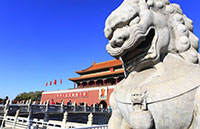Briton brings other side of 'war on terror'
Updated: 2016-08-02 10:39
(Agencies)
|
||||||||
 |
|
The War of Terror exhibition by British photographer Edmund Clark runs in London through Aug 28.[Photo/Agencies] |
A haunting picture of a forest and photographs of Guantanamo Bay-eerie rendition locations-lift the veil in art form on government methods to counter terror.
"Extraordinary rendition involved very ordinary places," says artist Edmund Clark, pointing at the forest picture, part of a new exhibition, War of Terror, which is running in London through Aug 28.
The exhibition's loose sequence starts with the theme of extraordinary rendition followed by photographs of the Guantanamo Bay prison and ends with the experience of a man subject to a form of house arrest for suspected jihadists in Britain.
British photographer Clark uses multimedia installations to portray "the unseen processes, sights and forms of control and incarceration" used by governments in the name of counterterrorism.
Extraordinary rendition, whereby suspects were transferred covertly to a third country or to US-run detention centers, became controversial immediately after it began following the terrorists attacks on Sept 11, 2001.
According to the Open Society foundation, there have been more than 100 individuals rendered by the CIA.
The Council of Europe found that 14 European countries had tolerated the secret transfer of terror suspects by the United States.
"I've used as many visual forms as possible to show the spectacle and scale. My aim is to show that the war on terror affects not only the geopolitical sphere but also the personal," Clark says.
"The theme that underpins everything is how terror affects all of our lives and changes the way we think about fear."
For the artist, it was important that the audience understand that some of the forms of control took place in ordinary places like suburban houses, hotels, or forests hiding military bases, and that inmates led normal lives before being taken away.
"Because of the media, it is easy to feel disconnected from these subjects," he says.
Clark became interested in the topic after he took some photographs of ex-Guantanamo prisoners having returned home to Britain.
He found the contrast between the lives of these people while in prison and their return to normality fascinating, and felt the need to expose this.
- Not for the faint-hearted: Glass bridge opens in Hunan
- Geneticist defends his groundbreaking technique
- Activist jailed for subversion, harming national security
- New Hainan port opens as annual fishing ban ends
- From hunting wild fruits to satellite dishes: Life of Myanmar returnees
- World's first panda-themed subway line runs in Chengdu

 From dusk to dawn: The other side of Beijing
From dusk to dawn: The other side of Beijing
 Huangluo: China's 'long hair village'
Huangluo: China's 'long hair village'
 Typhoon Nida lashes Shenzhen
Typhoon Nida lashes Shenzhen
 Amazing robots work hard at Qingdao beer fest
Amazing robots work hard at Qingdao beer fest
 Chinese swimmers 'test the water' in Rio
Chinese swimmers 'test the water' in Rio
 Amazing night view of Kaifeng in Henan province
Amazing night view of Kaifeng in Henan province
 In pics: Women soldier carrying the flag
In pics: Women soldier carrying the flag
 Rough and tough world of soldiers' training
Rough and tough world of soldiers' training
Most Viewed
Editor's Picks

|

|

|

|

|

|
Today's Top News
US launches airstrikes against IS targets in Libya's Sirte
Ministry slams US-Korean THAAD deployment
Two police officers shot at protest in Dallas
Abe's blame game reveals his policies failing to get results
Ending wildlife trafficking must be policy priority in Asia
Effects of supply-side reform take time to be seen
Chinese State Councilor Yang Jiechi to meet Kerry
Chinese stocks surge on back of MSCI rumors
US Weekly

|

|







